For our tour description, itinerary,
past triplists, dates, fees, and more, please VISIT OUR TOUR PAGE.
See this triplist in printable PDF format with media only on
page 1.
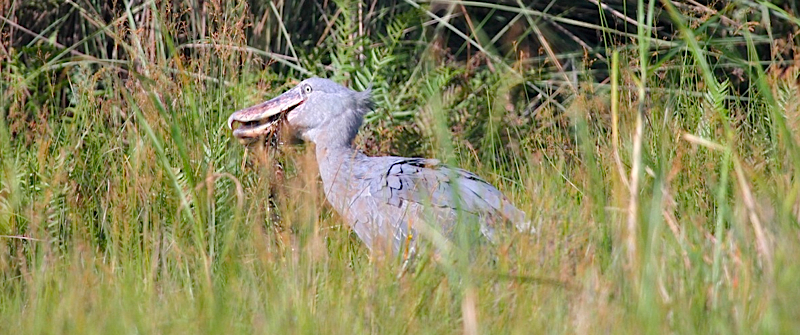
One of the main
targets for many on this trip, the prehistoric-looking
Shoebill (aka B. rex) is in a family of its own. This one
pounced on, then devoured, a lungfish as we watched from
close quarters on the first full day of the trip at Mabamba!
(Photo by guide Phil Gregory)
The Field Guides 2012 trip to Uganda, the Pearl of Africa,
was once more a great tour. It had again been a very wet start
to the year with heavy rain well into April, so the
countryside was verdant, and some birds seemed to be scarce or
absent. But this was compensated by some great looks at some
unusual species and terrific, charismatic mammal encounters,
with gorillas, chimpanzees, leopard, and lions all being
particularly memorable this year.
Our inaugural pre-trip walk to the Botanic Gardens was great,
with Bat Hawk, Gray Parrot and African Pied Hornbill as a nice
intro, repeated next day with an additional Wahlberg's
Honeyguide and a pair of African Hobby. We again went for
Shoebill in the papyrus swamps near Entebbe on the first day,
which got us off to a terrific start with close and prolonged
views (within 10 minutes!) of a Shoebill, which pounced on and
devoured a lungfish. Lesser Jacana was a good bonus bird here,
as was Orange Weaver and Blue-breasted Bee-eater.
The drive on the newly tarred road up to Masindi was good for
birds, with Dwarf Bittern an unexpected find, and great views
of widowbirds in breeding dress. Murchison is always a great
park, and big game was particularly rewarding, with a sighting
of a lioness with 2 large cubs on the north bank and fantastic
giraffes too. Good birds included multiple sightings of
Abyssinian Ground Hornbill, Stanley and Black-bellied
bustards, an immature Martial Eagle that stooped at a Nile
Monitor and landed right beside us, and Northern Carmine
Bee-eaters, one of which was endearingly using a rather
perplexed warthog as an ideal perch! The very local Red-winged
Gray Warbler came good, as did Rock Pratincole at the
positively raging Murchison Falls. The Victoria Nile boat trip
gave us a second Shoebill and a flight view of a pair of rare
Black Crowned-Cranes heading north (the black body a dead
giveaway, but how I wish they had been closer), plus curious
hippos, though crocs were amazingly scarce.
Driving out down the Rift Valley we had a pleasant stop at a
cloudy and for once less-than-sweltering Butiaba escarpment,
with Mocking Cliff-Chat and Foxy Cisticola showing well, and a
surprise Dwarf Bittern plus Shelley's Rufous Sparrow in the
lowlands north of the village. Budongo and the famous Royal
Mile gave us fabulous encounters with Shining-blue,
Chocolate-backed, Blue-breasted, and African Dwarf
kingfishers, plus a perched Barred Long-tailed Cuckoo, whilst
a male White-spotted Flufftail was very obliging. It was here
we had an amazing time with the chimps, who were coming in to
feed in a huge tree right by the track, followed by sundry
primate researchers. We saw over 30 of these entertaining
animals and got some great photos. The cultivation was also
rewarding with the scarce White-thighed Hornbill,
Black-bellied Firefinch, and Black Bishop.
The road to Kibale was, as usual, in poor condition, and it
took a while to get there, stopping en route for Papyrus
Gonolek and Yellow-spotted (Western) Nicator, plus
White-crested Turaco. Kibale National Park gave a good series
of chimp encounters, and the Bigodi Swamp walk gave us
Speckle-breasted Woodpecker, Great Sparrowhawk and 4 species
of primate feeding close together. It was great to see
Grey-cheeked Mangabey so well, as well as Black-cheeked
White-nosed Monkey, Mantled Guereza, and the rare Uganda Red
Colobus.
The beautiful Lodge at Mweya in Queen Elizabeth NP was as
ever a fantastic destination, and we all greatly enjoyed the
boat trip down the Kazinga Channel with the 170+ African
Skimmers and hippos at the waterside, with some brilliant
encounters with bathing elephants. Sadly, this year a huge
Congolese truck had broken a bridge through the Ishasha sector
of QENP, so we had to detour via Kithagata and Kanungu to get
to Bwindi, but it got us African Blue-Flycatcher and
Black-throated Canary as unexpected additions.
The Bwindi-Impenetrable Forest is always a major highlight,
with the gorillas seen really well by the gorilla trekkers,
who were all back at camp by late lunchtime. Birds were also
terrific, with Black Bee-eaters, White-bellied Robin-Chat,
Red-fronted Antpecker, and the newly described cryptic species
Willard's Sooty Boubou, plus Elliot's Woodpecker and the
delightful Black-faced Rufous-Warbler. This led us neatly into
the high altitude stop at Ruhija at the quite new and
comfortable lodge there. Here a select band made the lovely 10
km trek down into the Mubwindi Swamp, seeing Grauer's
Swamp-Warbler, Yellow-eyed Black-Flycatcher, a pair of Crowned
Eagles with a noisy juvenile, and a fantastic perched Cassin's
Hawk Eagle. We also had several sightings of the elusive
Oriole Finch plus Sitatunga out in the swamp, though sadly
there was no sign of nesting Grauer's Broadbill this year,
maybe due to the late rains.
Other Albertine Rift goodies included Handsome Francolin for
some, Archer's Robin-Chat, Blue-headed and Regal sunbirds,
Grauer's Warbler, Strange Weaver, Ruwenzori Apalis, Ruwenzori
Batis, Sharpe's and Waller's starlings, the astonishing
Doherty's Bush-Shrike and both Least and Dwarf honeyguides
—the endemic birds just kept on coming and we did extremely
well.
Lake Mburo was also very pleasant, with the camp newly
renovated and great birds like African Finfoot, Greater
Painted-Snipe, Red-headed Lovebird, the very local Red-faced
Barbet, and a close late afternoon encounter with Giant Eagle
Owl, plus a wonderful daylight sighting of Pearl-spotted
Owlet, with zebras, topi and impala also crowd-pleasers.
The finale at Mabira Forest added a bunch of new species
still, with Forest Woodhoopoe, Lesser Bristlebill, Sooty
Boubou, Purple-throated Cuckoo-Shrike, and a fantastic male
Black-bellied Seedcracker perched by his nest.
My thanks to Livingstone for being a great driver and bird
guide, also to Sharon for splendid arrangements, and to the
truly remarkable fieldman Alfred with his infrared eyesight
and bionic ears. Thanks also to Vincent, Moses, and Ismail,
who helped us so effectively. An entertaining and throroughly
enjoyable experience, we all had a really memorable tour—and
my thanks to the group for coming along and getting on so
well. This is a truly great trip, one of my favorites, so do
it whilst you can!
Why not join us for 2013 when Terry Stevenson will be doing
the honors (whilst I hope to be in Ethiopia)?
--Phil Gregory - June 2012 Queensland
KEYS FOR THIS LIST
One of the following keys may be shown in brackets for
individual species as appropriate: * = heard only, I =
introduced, E = endemic, N = nesting, a = austral migrant, b =
boreal migrant
Anatidae (Ducks, Geese, and Waterfowl)
WHITE-FACED WHISTLING-DUCK (Dendrocygna viduata)
COMB DUCK (Sarkidiornis melanotos)
EGYPTIAN GOOSE
(Alopochen aegyptiaca)
SPUR-WINGED GOOSE
(Plectropterus gambensis)
YELLOW-BILLED DUCK
(Anas undulata)

Though commonly
seen in zoos and aviaries around the world, Gray
Crowned-Cranes look even better in the wild! (Photo by
guide Phil Gregory)
RED-BILLED DUCK (Anas erythrorhyncha)
Numididae (Guineafowl)
HELMETED GUINEAFOWL (Numida meleagris)
CRESTED GUINEAFOWL
(Guttera pucherani)
Phasianidae (Pheasants, Grouse, and
Allies)
CRESTED FRANCOLIN (Francolinus sephaena)
SCALY FRANCOLIN
(Francolinus squamatus)
HEUGLIN'S
FRANCOLIN (Francolinus
icterorhynchus)
RED-NECKED
FRANCOLIN (Francolinus afer)
HANDSOME FRANCOLIN
(Francolinus nobilis)
Phoenicopteridae (Flamingos)
GREATER FLAMINGO (Phoenicopterus roseus)
LESSER FLAMINGO
(Phoenicopterus minor)
Ciconiidae (Storks)
AFRICAN OPENBILL (Anastomus lamelligerus)
WOOLLY-NECKED
STORK (Ciconia episcopus)
SADDLE-BILLED
STORK (Ephippiorhynchus
senegalensis)
MARABOU STORK
(Leptoptilos crumeniferus)
YELLOW-BILLED
STORK (Mycteria ibis)
Phalacrocoracidae (Cormorants and Shags)
GREAT CORMORANT (WHITE-BREASTED)
(Phalacrocorax carbo lucidus)
LONG-TAILED
CORMORANT (Phalacrocorax
africanus)
Anhingidae (Anhingas)
AFRICAN DARTER (Anhinga rufa rufa)
Pelecanidae (Pelicans)
PINK-BACKED PELICAN (Pelecanus rufescens)
Balaenicipitidae (Shoebill)
SHOEBILL (Balaeniceps
rex)
Scopidae (Hamerkop)
HAMERKOP (Scopus
umbretta)
Ardeidae (Herons, Egrets, and Bitterns)
LITTLE BITTERN (Ixobrychus minutus payesii)
DWARF BITTERN
(Ixobrychus sturmii)
GRAY HERON
(Ardea cinerea)
BLACK-HEADED HERON
(Ardea melanocephala)
GOLIATH HERON
(Ardea goliath)
PURPLE HERON
(Ardea purpurea)
GREAT EGRET
(Ardea alba)
INTERMEDIATE EGRET
(Mesophoyx intermedia)
LITTLE EGRET
(Egretta garzetta)
CATTLE EGRET
(Bubulcus ibis)
SQUACCO HERON
(Ardeola ralloides)
STRIATED HERON
(Butorides striata)
BLACK-CROWNED
NIGHT-HERON (Nycticorax
nycticorax)
Threskiornithidae (Ibises and Spoonbills)
SACRED IBIS (Threskiornis aethiopicus)
HADADA IBIS
(Bostrychia hagedash)
AFRICAN SPOONBILL
(Platalea alba)
Accipitridae (Hawks, Eagles, and Kites)
EUROPEAN HONEY-BUZZARD (Pernis apivorus)
BAT HAWK (Macheiramphus alcinus)
BLACK-SHOULDERED
KITE (Elanus caeruleus)
BLACK KITE
(YELLOW-BILLED) (Milvus
migrans parasitus)
AFRICAN FISH-EAGLE
(Haliaeetus vocifer)
PALM-NUT VULTURE
(Gypohierax angolensis)
HOODED VULTURE
(Necrosyrtes monachus)
WHITE-BACKED
VULTURE (Gyps africanus)
LAPPET-FACED
VULTURE (Torgos tracheliotus)
WHITE-HEADED
VULTURE (Trigonoceps
occipitalis)
BLACK-BREASTED
SNAKE-EAGLE (Circaetus
pectoralis)
BROWN SNAKE-EAGLE
(Circaetus cinereus)
BANDED SNAKE-EAGLE
(Circaetus cinerascens)
BATELEUR (Terathopius ecaudatus)
AFRICAN
MARSH-HARRIER (Circus
ranivorus)
AFRICAN
HARRIER-HAWK (Polyboroides
typus)
LIZARD BUZZARD
(Kaupifalco monogrammicus)
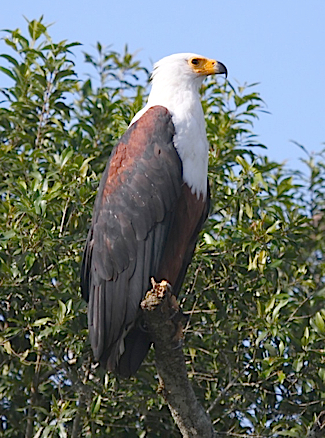
In the same genus
as the Bald Eagle of North America, the handsome African
Fish-Eagle is a common sight at lakes and wetlands
throughout Africa. (Photo by guide Phil Gregory)
DARK CHANTING-GOSHAWK (Melierax metabates)
GABAR GOSHAWK
(Micronisus gabar)
AFRICAN GOSHAWK
(Accipiter tachiro)
SHIKRA (Accipiter badius)
BLACK GOSHAWK
(Accipiter melanoleucus)
MOUNTAIN BUZZARD
(Buteo oreophilus)
AUGUR BUZZARD
(Buteo augur)
CASSIN'S
HAWK-EAGLE (Aquila africana)
WAHLBERG'S EAGLE
(Hieraaetus wahlbergi)
MARTIAL EAGLE
(Polemaetus bellicosus)
LONG-CRESTED EAGLE
(Lophaetus occipitalis)
CROWNED HAWK-EAGLE
(Stephanoaetus coronatus)
Falconidae (Falcons and Caracaras)
GRAY KESTREL (Falco ardosiaceus)
AFRICAN HOBBY
(Falco cuvierii)
Otididae (Bustards)
STANLEY BUSTARD (Neotis denhami denhami)
BLACK-BELLIED
BUSTARD (Lissotis
melanogaster)
Rallidae (Rails, Gallinules, and Coots)
WHITE-SPOTTED FLUFFTAIL (Sarothrura pulchra)
RED-CHESTED
FLUFFTAIL (Sarothrura rufa)
[*]
AFRICAN CRAKE
(Crecopsis egregia)
BLACK CRAKE
(Amaurornis flavirostra)
LESSER MOORHEN
(Gallinula angulata)
Heliornithidae (Finfoots)
AFRICAN FINFOOT (Podica senegalensis)
Gruidae (Cranes)
GRAY CROWNED-CRANE (Balearica regulorum)
BLACK
CROWNED-CRANE (Balearica
pavonina)
Burhinidae (Thick-knees)
WATER THICK-KNEE (Burhinus vermiculatus)
Charadriidae (Plovers and Lapwings)
LONG-TOED LAPWING (Vanellus crassirostris)
SPUR-WINGED PLOVER
(Vanellus spinosus)
SENEGAL LAPWING
(Vanellus lugubris)
WATTLED LAPWING
(Vanellus senegallus)
KITTLITZ'S PLOVER
(Charadrius pecuarius)
Recurvirostridae (Stilts and Avocets)
BLACK-WINGED STILT (Himantopus himantopus)
Jacanidae (Jacanas)
LESSER JACANA (Microparra capensis)
AFRICAN JACANA
(Actophilornis africanus)
Glareolidae (Pratincoles and Coursers)
COLLARED PRATINCOLE (Glareola pratincola)
ROCK PRATINCOLE
(Glareola nuchalis)
Rostratulidae (Painted-Snipes)
GREATER PAINTED-SNIPE (Rostratula benghalensis)
Laridae (Gulls, Terns, and Skimmers)
GRAY-HOODED GULL (Chroicocephalus cirrocephalus)
GULL-BILLED TERN
(Gelochelidon nilotica)
WHITE-WINGED TERN
(Chlidonias leucopterus)
AFRICAN SKIMMER
(Rynchops flavirostris)
Columbidae (Pigeons and Doves)
ROCK PIGEON (Columba livia) [I]
SPECKLED PIGEON
(Columba guinea)
AFEP PIGEON
(Columba unicincta)
RAMERON PIGEON
(Columba arquatrix)
BRONZE-NAPED
PIGEON (Columba iriditorques)
[*]
MOURNING
COLLARED-DOVE (Streptopelia
decipiens)
RED-EYED DOVE
(Streptopelia semitorquata)
RING-NECKED DOVE
(Streptopelia capicola)
VINACEOUS DOVE
(Streptopelia vinacea)
LAUGHING DOVE
(Streptopelia senegalensis)
EMERALD-SPOTTED
WOOD-DOVE (Turtur
chalcospilos)
BLACK-BILLED
WOOD-DOVE (Turtur abyssinicus)
BLUE-SPOTTED
WOOD-DOVE (Turtur afer)
TAMBOURINE DOVE
(Turtur tympanistria)
AFRICAN
GREEN-PIGEON (Treron calvus)
Psittacidae (Parrots)
RED-HEADED LOVEBIRD (Agapornis pullarius)
GRAY PARROT
(Psittacus erithacus)
MEYER'S PARROT
(Poicephalus meyeri)
Musophagidae (Turacos)
GREAT BLUE TURACO (Corythaeola cristata)
BLACK-BILLED
TURACO (Tauraco schuettii)
WHITE-CRESTED
TURACO (Tauraco leucolophus)
ROSS'S TURACO
(Musophaga rossae)
BARE-FACED
GO-AWAY-BIRD (Corythaixoides
personatus)
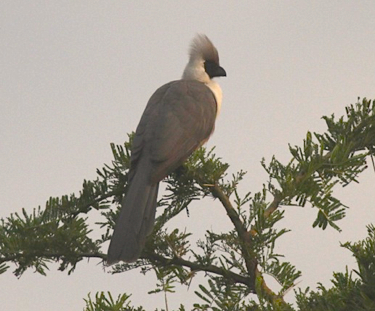
The
evocatively-named Bare-faced Go-away-bird is rather local
in Uganda, and as usual we saw this large turaco only in
the acacia scrub around Lake Mburo. (Photo by guide Phil
Gregory)
EASTERN PLANTAIN-EATER (Crinifer zonurus)
Cuculidae (Cuckoos)
LEVAILLANT'S CUCKOO (Clamator levaillantii)
RED-CHESTED CUCKOO
(Cuculus solitarius)
BLACK CUCKOO
(Cuculus clamosus clamosus)
AFRICAN CUCKOO
(Cuculus gularis)
DUSKY LONG-TAILED
CUCKOO (Cercococcyx mechowi)
BARRED LONG-TAILED
CUCKOO (Cercococcyx montanus)
KLAAS'S CUCKOO
(Chrysococcyx klaas)
AFRICAN EMERALD
CUCKOO (Chrysococcyx cupreus)
DIDERIC CUCKOO
(Chrysococcyx caprius)
YELLOWBILL
(Ceuthmochares aereus)
BLACK COUCAL
(Centropus grillii)
BLUE-HEADED COUCAL
(Centropus monachus)
WHITE-BROWED
COUCAL (Centropus
superciliosus)
Strigidae (Owls)
AFRICAN SCOPS-OWL (Otus senegalensis) [*]
VERREAUX'S
EAGLE-OWL (Bubo lacteus)
PEARL-SPOTTED
OWLET (Glaucidium perlatum)
AFRICAN WOOD-OWL
(Strix woodfordii) [*]
Caprimulgidae (Nightjars and Allies)
BLACK-SHOULDERED NIGHTJAR (Caprimulgus nigriscapularis) [*]
MONTANE NIGHTJAR
(Caprimulgus ruwenzorii)
[*]
SQUARE-TAILED
NIGHTJAR (Caprimulgus fossii)
[*]
Apodidae (Swifts)
SABINE'S SPINETAIL (Rhaphidura sabini)
SCARCE SWIFT
(Schoutedenapus myoptilus)
ALPINE SWIFT
(Apus melba)
LITTLE SWIFT
(Apus affinis)
HORUS SWIFT
(Apus horus)
WHITE-RUMPED SWIFT
(Apus caffer)
AFRICAN PALM-SWIFT
(Cypsiurus parvus)
Coliidae (Mousebirds)
SPECKLED MOUSEBIRD (Colius striatus)
BLUE-NAPED
MOUSEBIRD (Urocolius
macrourus)
Trogonidae (Trogons)
NARINA TROGON (Apaloderma narina)
BAR-TAILED TROGON
(Apaloderma vittatum)
Alcedinidae (Kingfishers)
SHINING-BLUE KINGFISHER (Alcedo quadribrachys)
MALACHITE
KINGFISHER (Corythornis
cristatus)
AFRICAN
PYGMY-KINGFISHER (Ispidina
picta)
DWARF KINGFISHER
(Ispidina lecontei)
CHOCOLATE-BACKED
KINGFISHER (Halcyon badia)
GRAY-HEADED
KINGFISHER (Halcyon
leucocephala)
WOODLAND
KINGFISHER (Halcyon
senegalensis)
BLUE-BREASTED
KINGFISHER (Halcyon malimbica)
STRIPED KINGFISHER
(Halcyon chelicuti)
GIANT KINGFISHER
(Megaceryle maximus)
PIED KINGFISHER
(Ceryle rudis)
Meropidae (Bee-eaters)
BLACK BEE-EATER (Merops gularis)
RED-THROATED
BEE-EATER (Merops bulocki)
LITTLE BEE-EATER
(Merops pusillus)
BLUE-BREASTED
BEE-EATER (Merops variegatus)
CINNAMON-CHESTED
BEE-EATER (Merops oreobates)
SWALLOW-TAILED
BEE-EATER (Merops hirundineus)
WHITE-THROATED
BEE-EATER (Merops albicollis)
MADAGASCAR
BEE-EATER (Merops
superciliosus)
NORTHERN CARMINE
BEE-EATER (Merops nubicus)
Coraciidae (Rollers)
LILAC-BREASTED ROLLER (Coracias caudatus)
BROAD-BILLED
ROLLER (Eurystomus glaucurus)
BLUE-THROATED
ROLLER (Eurystomus gularis)
Upupidae (Hoopoes)
EURASIAN HOOPOE (AFRICAN) (Upupa epops africana)
Phoeniculidae (Woodhoopoes and
Scimitar-bills)
GREEN WOODHOOPOE (Phoeniculus purpureus)
WHITE-HEADED
WOODHOOPOE (Phoeniculus
bollei)
FOREST WOODHOOPOE
(Phoeniculus castaneiceps)
Bucerotidae (Hornbills)
CROWNED HORNBILL (Tockus alboterminatus)
AFRICAN PIED
HORNBILL (Tockus fasciatus)
AFRICAN GRAY
HORNBILL (Tockus nasutus)
BLACK-AND-WHITE-CASQUED
HORNBILL (Ceratogymna
subcylindrica)
WHITE-THIGHED
HORNBILL (Ceratogymna
albotibialis)
ABYSSINIAN
GROUND-HORNBILL (Bucorvus
abyssinicus)
Lybiidae (African Barbets)
YELLOW-BILLED BARBET (Trachyphonus purpuratus) [*]
GRAY-THROATED
BARBET (Gymnobucco bonapartei)
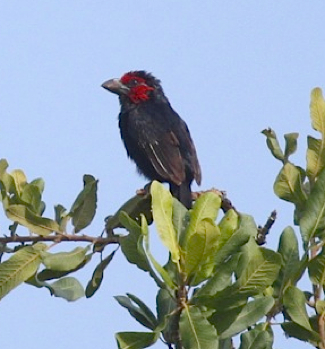
Red-faced Barbet
is a localized east African endemic, found only in a small
area to the west of Lake Victoria. We did well to find
three of these at Lake Mburo, pretty much the only site
for this species in Uganda. (Photo by guide Phil Gregory)
SPECKLED TINKERBIRD (Pogoniulus scolopaceus)
WESTERN TINKERBIRD
(Pogoniulus coryphaeus)
YELLOW-THROATED
TINKERBIRD (Pogoniulus
subsulphureus)
YELLOW-RUMPED
TINKERBIRD (Pogoniulus
bilineatus)
YELLOW-FRONTED
TINKERBIRD (Pogoniulus
chrysoconus)
YELLOW-SPOTTED
BARBET (Buccanodon duchaillui)
HAIRY-BREASTED
BARBET (Tricholaema hirsuta)
SPOT-FLANKED
BARBET (Tricholaema lacrymosa)
WHITE-HEADED
BARBET (Lybius leucocephalus)
RED-FACED BARBET
(Lybius rubrifacies)
BLACK-BILLED
BARBET (Lybius guifsobalito)
DOUBLE-TOOTHED
BARBET (Lybius bidentatus)
Indicatoridae (Honeyguides)
CASSIN'S HONEYGUIDE (Prodotiscus insignis)
WAHLBERG'S
HONEYGUIDE (Prodotiscus
regulus)
DWARF HONEYGUIDE
(Indicator pumilio)
LEAST HONEYGUIDE
(Indicator exilis)
Picidae (Woodpeckers)
RUFOUS-NECKED WRYNECK (Jynx ruficollis)
NUBIAN WOODPECKER
(Campethera nubica)
BROWN-EARED
WOODPECKER (Campethera caroli)
SPECKLE-BREASTED
WOODPECKER (Dendropicos
poecilolaemus)
CARDINAL
WOODPECKER (Dendropicos
fuscescens)
GOLDEN-CROWNED
WOODPECKER (Dendropicos
xantholophus)
ELLIOT'S
WOODPECKER (Dendropicos
elliotii)
GRAY WOODPECKER
(Dendropicos goertae)
OLIVE WOODPECKER
(Dendropicos griseocephalus)
Platysteiridae (Wattle-eyes and Batises)
AFRICAN SHRIKE-FLYCATCHER (Megabyas flammulatus)
BLACK-AND-WHITE
SHRIKE-FLYCATCHER (Bias
musicus)
BROWN-THROATED
WATTLE-EYE (Platysteira
cyanea)
CHESTNUT
WATTLE-EYE (Platysteira
castanea)
JAMESON'S
WATTLE-EYE (Platysteira
jamesoni)
[*]
RUWENZORI BATIS
(Batis diops)
CHINSPOT BATIS
(Batis molitor)
BLACK-HEADED BATIS
(Batis minor)
ITURI BATIS
(Batis ituriensis) [*]
Prionopidae (Helmetshrikes and Allies)
WHITE HELMETSHRIKE (Prionops plumatus)
Malaconotidae (Bushshrikes and Allies)
BRUBRU (Nilaus
afer)
NORTHERN PUFFBACK
(Dryoscopus gambensis)
PINK-FOOTED
PUFFBACK (Dryoscopus
angolensis)
MARSH TCHAGRA
(Tchagra minutus minutus)
BLACK-CROWNED
TCHAGRA (Tchagra senegalus)
BROWN-CROWNED
TCHAGRA (Tchagra australis)
LUEHDER'S
BUSHSHRIKE (Laniarius
luehderi)
TROPICAL BOUBOU
(Laniarius aethiopicus)
BLACK-HEADED
GONOLEK (Laniarius
erythrogaster)
PAPYRUS GONOLEK
(Laniarius mufumbiri)
SOOTY BOUBOU
(Laniarius leucorhynchus)
WILLARD'S SOOTY
BOUBOU (Laniarius willardi)
MOUNTAIN SOOTY
BOUBOU (Laniarius poensis)
[*]
GRAY-GREEN
BUSHSHRIKE (Telophorus
bocagei)
SULPHUR-BREASTED
BUSHSHRIKE (Telophorus
sulfureopectus)
DOHERTY'S
BUSHSHRIKE (Telophorus
dohertyi)
GRAY-HEADED
BUSHSHRIKE (Malaconotus
blanchoti) [*]
Campephagidae (Cuckoo-shrikes)
GRAY CUCKOO-SHRIKE (Coracina caesia)
PETIT'S
CUCKOO-SHRIKE (Campephaga
petiti)
BLACK
CUCKOO-SHRIKE (Campephaga
flava)
PURPLE-THROATED
CUCKOO-SHRIKE (Campephaga
quiscalina)
Laniidae (Shrikes)
GRAY-BACKED FISCAL (Lanius excubitoroides)
MACKINNON'S SHRIKE
(Lanius mackinnoni)
COMMON FISCAL
(Lanius collaris)
Oriolidae (Old World Orioles)
WESTERN BLACK-HEADED ORIOLE (Oriolus brachyrhynchus)
AFRICAN
BLACK-HEADED ORIOLE (Oriolus
larvatus)
BLACK-TAILED
ORIOLE (Oriolus percivali)
Dicruridae (Drongos)
FORK-TAILED DRONGO (Dicrurus adsimilis)
VELVET-MANTLED
DRONGO (Dicrurus modestus
modestus)
Monarchidae (Monarch Flycatchers)
BLACK-HEADED PARADISE-FLYCATCHER
(Terpsiphone rufiventer)
AFRICAN
PARADISE-FLYCATCHER (Terpsiphone
viridis)
Corvidae (Crows, Jays, and Magpies)
PIAPIAC (Ptilostomus
afer)
PIED CROW (Corvus albus)
WHITE-NECKED RAVEN
(Corvus albicollis)
Nicatoridae (Nicators)
YELLOW-SPOTTED NICATOR (Nicator chloris)
Alaudidae (Larks)
WHITE-TAILED LARK (Mirafra albicauda)
RUFOUS-NAPED LARK
(Mirafra africana)
FLAPPET LARK
(Mirafra rufocinnamomea)
Hirundinidae (Swallows)
PLAIN MARTIN (Riparia paludicola)
BANDED MARTIN
(Riparia cincta)
ROCK MARTIN
(Ptyonoprogne fuligula)
ANGOLA SWALLOW
(Hirundo angolensis)
WIRE-TAILED
SWALLOW (Hirundo smithii)
RED-RUMPED SWALLOW
(Cecropis daurica)
LESSER
STRIPED-SWALLOW (Cecropis
abyssinica)
RUFOUS-CHESTED
SWALLOW (Cecropis semirufa)
MOSQUE SWALLOW
(Cecropis senegalensis)
WHITE-HEADED
SAWWING (Psalidoprocne
albiceps)
BLACK SAWWING
(Psalidoprocne pristoptera)
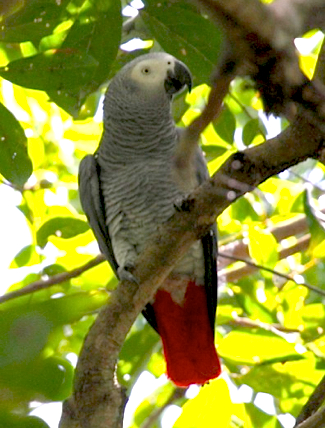
Though Gray
Parrot numbers are declining in many regions, you wouldn't
have known it from this trip, as we saw them in higher
than normal numbers, starting with this very cooperative
bird at the Entebbe Botanical Gardens. (Photo by guide
Phil Gregory)
GRAY-RUMPED SWALLOW (Pseudhirundo griseopyga)
Stenostiridae (Fairy Flycatchers)
AFRICAN BLUE-FLYCATCHER (Elminia longicauda)
WHITE-TAILED
BLUE-FLYCATCHER (Elminia
albicauda)
WHITE-BELLIED
CRESTED-FLYCATCHER (Elminia
albiventris)
Paridae (Chickadees and Tits)
WHITE-WINGED BLACK-TIT (Melaniparus leucomelas)
WHITE-SHOULDERED
BLACK-TIT (Melaniparus
guineensis)
DUSKY TIT (Melaniparus funereus)
STRIPE-BREASTED
TIT (Melaniparus fasciiventer)
Pycnonotidae (Bulbuls)
SLENDER-BILLED GREENBUL (Stelgidillas gracilirostris gracilirostris)
COMMON BRISTLEBILL
(Bleda syndactylus woosnami)
LESSER BRISTLEBILL
(Bleda notatus ugandae)
SHELLEY'S GREENBUL
(KAKAMEGA) (Arizelocichla
masukuensis kakamegae)
EASTERN
MOUNTAIN-GREENBUL (OLIVE-BREASTED) (Arizelocichla nigriceps kikuyuensis)
HONEYGUIDE
GREENBUL (Baeopogon indicator)
[*]
YELLOW-THROATED
GREENBUL (Atimastillas
flavicollis)
SPOTTED GREENBUL
(Ixonotus guttatus)
RED-TAILED
GREENBUL (Criniger calurus
emini)
GRAY GREENBUL
(Eurillas gracilis ugandae)
ANSORGE'S GREENBUL
(Eurillas ansorgei)
PLAIN GREENBUL
(Eurillas curvirostris)
YELLOW-WHISKERED
GREENBUL (Eurillas
latirostris)
LITTLE GREENBUL
(Eurillas virens virens)
CABANIS'S GREENBUL
(Phyllastrephus cabanisi)
WHITE-THROATED
GREENBUL (Phyllastrephus
albigularis albigularis)
YELLOW-STREAKED
GREENBUL (YELLOW-STREAKED) (Phyllastrephus
flavostriatus olivaceogriseus)
COMMON BULBUL
(DARK-CAPPED) (Pycnonotus
barbatus tricolor)
Macrosphenidae (African Warblers)
GREEN CROMBEC (Sylvietta virens)
LEMON-BELLIED
CROMBEC (Sylvietta denti)
WHITE-BROWED
CROMBEC (Sylvietta leucophrys)
NORTHERN CROMBEC
(Sylvietta brachyura)
MOUSTACHED
GRASS-WARBLER (Melocichla
mentalis)
GRAY LONGBILL
(Macrosphenus concolor)
Cettiidae (Bush-Warblers and Allies)
CHESTNUT-CAPPED FLYCATCHER (Erythrocercus mccallii)
Phylloscopidae (Leaf-Warblers)
RED-FACED WOODLAND-WARBLER (Phylloscopus laetus)
UGANDA
WOOD-WARBLER (Phylloscopus
budongoensis)
Acrocephalidae (Reed-Warblers and Allies)
AFRICAN YELLOW WARBLER (Chloropeta natalensis)
MOUNTAIN YELLOW
WARBLER (Chloropeta similis)
LESSER
SWAMP-WARBLER (Acrocephalus
gracilirostris)
[*]
Locustellidae (Grassbirds and Allies)
WHITE-WINGED SWAMP-WARBLER (Bradypterus carpalis) [*]
GRAUER'S
SWAMP-WARBLER (Bradypterus
graueri)
EVERGREEN-FOREST
WARBLER (Bradypterus lopezi
barakae)
CINNAMON
BRACKEN-WARBLER (Bradypterus
cinnamomeus) [*]
FAN-TAILED
GRASSBIRD (Schoenicola
brevirostris)
Cisticolidae (Cisticolas and Allies)
RUWENZORI APALIS (Apalis ruwenzorii)
BLACK-THROATED
APALIS (Apalis jacksoni)
MASKED APALIS
(Apalis binotata) [*]
BLACK-FACED APALIS
(Apalis personata)
BUFF-THROATED
APALIS (Apalis rufogularis)
CHESTNUT-THROATED
APALIS (Apalis porphyrolaema)
GRAY APALIS
(Apalis cinerea)
GREEN-BACKED
CAMAROPTERA (GRAY-BACKED) (Camaroptera
brachyura brevicaudata)
OLIVE-GREEN
CAMAROPTERA (Camaroptera
chloronota)
WHITE-CHINNED
PRINIA (Schistolais
leucopogon)
RED-WINGED GRAY
WARBLER (Drymocichla incana)
RED-FACED
CISTICOLA (Cisticola
erythrops)
SINGING CISTICOLA
(Cisticola cantans)
WHISTLING
CISTICOLA (Cisticola
lateralis)
TRILLING CISTICOLA
(Cisticola woosnami)
CHUBB'S CISTICOLA
(Cisticola chubbi)
RATTLING CISTICOLA
(Cisticola chiniana)
WINDING CISTICOLA
(Cisticola galactotes)
CARRUTHERS'S
CISTICOLA (Cisticola
carruthersi)
CROAKING CISTICOLA
(Cisticola natalensis)
SIFFLING CISTICOLA
(Cisticola brachypterus)
FOXY CISTICOLA
(Cisticola troglodytes)
ZITTING CISTICOLA
(Cisticola juncidis)
GRAY-CAPPED
WARBLER (Eminia lepida)
BLACK-FACED
RUFOUS-WARBLER (Bathmocercus
rufus)
BUFF-BELLIED
WARBLER (Phyllolais pulchella)
TAWNY-FLANKED
PRINIA (Prinia subflava)
BANDED PRINIA
(BANDED) (Prinia bairdii
obscura)
GREEN-BACKED
EREMOMELA (Eremomela
canescens)
RUFOUS-CROWNED
EREMOMELA (Eremomela badiceps)
Sylviidae (Old World Warblers)
AFRICAN HILL BABBLER (Pseudoalcippe abyssinica atriceps)
GRAUER'S WARBLER
(Graueria vittata)
GREEN HYLIA
(Hylia prasina)
Zosteropidae (Yuhinas, White-eyes, and
Allies)
AFRICAN YELLOW WHITE-EYE (Zosterops senegalensis)
Pellorneidae (Fulvettas and Ground
Babblers)
SCALY-BREASTED ILLADOPSIS (Illadopsis albipectus) [*]
PALE-BREASTED
ILLADOPSIS (Illadopsis
rufipennis)
BROWN ILLADOPSIS
(Illadopsis fulvescens) [*]
MOUNTAIN
ILLADOPSIS (Illadopsis
pyrrhoptera)
Leiothrichidae (Laughingthrushes)
BLACK-LORED BABBLER (Turdoides sharpei)
BROWN BABBLER
(Turdoides plebejus)
ARROW-MARKED
BABBLER (Turdoides jardineii)
Hyliotidae (Hyliotas)
YELLOW-BELLIED HYLIOTA (Hyliota flavigaster)
Muscicapidae (Old World Flycatchers)
SILVERBIRD (Empidornis
semipartitus)
PALE FLYCATCHER
(Bradornis pallidus)
WHITE-EYED
SLATY-FLYCATCHER (Melaenornis
fischeri)
NORTHERN
BLACK-FLYCATCHER (Melaenornis
edolioides)
SOUTHERN
BLACK-FLYCATCHER (Melaenornis
pammelaina)
YELLOW-EYED
BLACK-FLYCATCHER (Melaenornis
ardesiacus)
AFRICAN
FOREST-FLYCATCHER (Fraseria
ocreata)
SOOTY FLYCATCHER
(Muscicapa infuscata)
SWAMP FLYCATCHER
(Muscicapa aquatica)
CHAPIN'S
FLYCATCHER (Muscicapa lendu)
DUSKY-BROWN
FLYCATCHER (Muscicapa adusta)
DUSKY-BLUE
FLYCATCHER (Muscicapa
comitata)
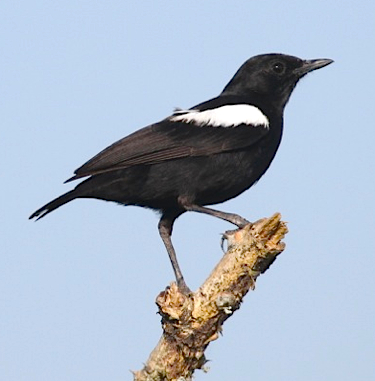
Sooty Chat is a
familiar sight in the Ugandan countryside. (Photo by guide
Phil Gregory)
CASSIN'S FLYCATCHER (Muscicapa cassini)
GRAY-THROATED
TIT-FLYCATCHER (Myioparus
griseigularis)
GRAY
TIT-FLYCATCHER (Myioparus
plumbeus)
FIRE-CRESTED
ALETHE (FIRE-CRESTED) (Alethe
diademata castanea) [*]
BROWN-BACKED
SCRUB-ROBIN (Cercotrichas
hartlaubi)
RED-BACKED
SCRUB-ROBIN (Cercotrichas
leucophrys) [*]
WHITE-BELLIED
ROBIN-CHAT (Cossyphicula
roberti)
ARCHER'S
ROBIN-CHAT (Cossypha archeri)
BLUE-SHOULDERED
ROBIN-CHAT (Cossypha
cyanocampter)
GRAY-WINGED
ROBIN-CHAT (Cossypha
polioptera) [*]
WHITE-BROWED
ROBIN-CHAT (Cossypha heuglini)
RED-CAPPED
ROBIN-CHAT (Cossypha
natalensis)
SNOWY-CROWNED
ROBIN-CHAT (Cossypha
niveicapilla)
SPOTTED
MORNING-THRUSH (Cichladusa
guttata)
WHITE-STARRED
ROBIN (Pogonocichla stellata)
RED-THROATED
ALETHE (Pseudalethe
poliophrys)
FOREST ROBIN
(EASTERN) (Stiphrornis
erythrothorax xanthogaster)
EQUATORIAL AKALAT
(Sheppardia aequatorialis)
STONECHAT
(AFRICAN) (Saxicola torquatus
axillaris)
SOOTY CHAT
(Myrmecocichla nigra)
MOCKING CLIFF-CHAT
(Thamnolaea cinnamomeiventris
subrufipennis)
Turdidae (Thrushes and Allies)
RUFOUS FLYCATCHER-THRUSH (Neocossyphus fraseri)
RED-TAILED
ANT-THRUSH (Neocossyphus
rufus)
WHITE-TAILED
ANT-THRUSH (Neocossyphus
poensis)
OLIVE THRUSH
(Turdus olivaceus)
AFRICAN THRUSH
(Turdus pelios)
Sturnidae (Starlings)
WATTLED STARLING (Creatophora cinerea)
GREATER BLUE-EARED
GLOSSY-STARLING (Lamprotornis
chalybaeus)
LESSER BLUE-EARED
GLOSSY-STARLING (Lamprotornis
chloropterus)
BRONZE-TAILED
GLOSSY-STARLING (Lamprotornis
chalcurus)
SPLENDID
GLOSSY-STARLING (Lamprotornis
splendidus)
PURPLE
GLOSSY-STARLING (Lamprotornis
purpureus)
RUEPPELL'S
GLOSSY-STARLING (Lamprotornis
purpuroptera)
PURPLE-HEADED
GLOSSY-STARLING (Lamprotornis
purpureiceps)
VIOLET-BACKED
STARLING (Cinnyricinclus
leucogaster)
SLENDER-BILLED
STARLING (Onychognathus
tenuirostris)
WALLER'S STARLING
(Onychognathus walleri)
NARROW-TAILED
STARLING (Poeoptera lugubris)
STUHLMANN'S
STARLING (Poeoptera
stuhlmanni)
SHARPE'S STARLING
(Pholia sharpii)
Buphagidae (Oxpeckers)
YELLOW-BILLED OXPECKER (Buphagus africanus)
Nectariniidae (Sunbirds and Spiderhunters)
GRAY-HEADED SUNBIRD (Deleornis axillaris)
WESTERN
VIOLET-BACKED SUNBIRD (NORTHERN) (Anthreptes longuemarei longuemarei)
LITTLE GREEN
SUNBIRD (Anthreptes seimundi)
GREEN SUNBIRD
(GRAY-THROATED) (Anthreptes
rectirostris tephrolaemus)
COLLARED SUNBIRD
(Hedydipna collaris garguensis)
GREEN-HEADED
SUNBIRD (GREEN-HEADED) (Cyanomitra
verticalis viridisplendens)
BLUE-HEADED
SUNBIRD (Cyanomitra alinae
alinae)
WESTERN OLIVE
SUNBIRD (Cyanomitra obscura)
GREEN-THROATED
SUNBIRD (Chalcomitra
rubescens)
SCARLET-CHESTED
SUNBIRD (Chalcomitra
senegalensis lamperti)
BRONZE SUNBIRD
(Nectarinia kilimensis kilimensis)
OLIVE-BELLIED
SUNBIRD (Cinnyris
chloropygius)
NORTHERN
DOUBLE-COLLARED SUNBIRD (Cinnyris
reichenowi preussi)
REGAL SUNBIRD
(Cinnyris regius regius)
BEAUTIFUL SUNBIRD
(Cinnyris pulchellus pulchellus)
MARIQUA SUNBIRD
(Cinnyris mariquensis suahelicus)
RED-CHESTED
SUNBIRD (Cinnyris
erythrocercus)
PURPLE-BANDED
SUNBIRD (Cinnyris bifasciatus)
SUPERB SUNBIRD
(Cinnyris superbus)
VARIABLE SUNBIRD
(ORANGE-CHESTED) (Cinnyris
venustus igneiventris)
COPPER SUNBIRD
(Cinnyris cupreus cupreus)
Motacillidae (Wagtails and Pipits)
CAPE WAGTAIL (Motacilla capensis)
MOUNTAIN WAGTAIL
(Motacilla clara)
AFRICAN PIED
WAGTAIL (Motacilla aguimp)
AFRICAN PIPIT
(Anthus cinnamomeus)
PLAIN-BACKED PIPIT
(Anthus leucophrys)
YELLOW-THROATED
LONGCLAW (Macronyx croceus)
Emberizidae (Buntings, Sparrows and
Allies)
CINNAMON-BREASTED BUNTING (Emberiza tahapisi)
GOLDEN-BREASTED
BUNTING (Emberiza
flaviventris)
BROWN-RUMPED
BUNTING (Emberiza affinis)
[*]
Fringillidae (Siskins, Crossbills, and
Allies)
ORIOLE FINCH (Linurgus olivaceus prigoginei)
YELLOW-CROWNED
CANARY (Serinus flavivertex
sassii)
WHITE-RUMPED
SEEDEATER (Serinus leucopygius
leucopygius)
YELLOW-FRONTED
CANARY (Serinus mozambicus)
WESTERN CITRIL
(Serinus frontalis)
BLACK-THROATED
CANARY (Serinus atrogularis
somereni)
BRIMSTONE CANARY
(Serinus sulphuratus sharpii)
STREAKY SEEDEATER
(Serinus striolatus graueri)
THICK-BILLED
SEEDEATER (Serinus burtoni
kilimensis)
Passeridae (Old World Sparrows)
HOUSE SPARROW (Passer domesticus) [I]
SHELLEY'S RUFOUS
SPARROW (Passer shelleyi)
NORTHERN
GRAY-HEADED SPARROW (Passer
griseus)
Ploceidae (Weavers and Allies)
SPECKLE-FRONTED WEAVER (Sporopipes frontalis)
CHESTNUT-CROWNED
SPARROW-WEAVER (Plocepasser
superciliosus)
RED-HEADED MALIMBE
(Malimbus rubricollis)
RED-HEADED WEAVER
(Anaplectes rubriceps)
BAGLAFECHT WEAVER
(Ploceus baglafecht)
LITTLE WEAVER
(Ploceus luteolus)
SLENDER-BILLED
WEAVER (Ploceus pelzelni)
BLACK-NECKED
WEAVER (Ploceus nigricollis)
SPECTACLED WEAVER
(Ploceus ocularis)
BLACK-BILLED
WEAVER (Ploceus melanogaster)
STRANGE WEAVER
(Ploceus alienus)
HOLUB'S
GOLDEN-WEAVER (Ploceus
xanthops)
ORANGE WEAVER
(Ploceus aurantius)
NORTHERN
BROWN-THROATED WEAVER (Ploceus
castanops)
LESSER
MASKED-WEAVER (Ploceus
intermedius)
VITELLINE
MASKED-WEAVER (Ploceus
vitellinus)
VIEILLOT'S WEAVER
(Ploceus nigerrimus)
VILLAGE WEAVER
(Ploceus cucullatus)
BLACK-HEADED
WEAVER (Ploceus
melanocephalus)
GOLDEN-BACKED
WEAVER (Ploceus jacksoni)
YELLOW-MANTLED
WEAVER (Ploceus tricolor)
BROWN-CAPPED
WEAVER (Ploceus insignis)
COMPACT WEAVER
(Pachyphantes superciliosus)
RED-BILLED QUELEA
(Quelea quelea)
ORANGE BISHOP
(Euplectes franciscanus)
RED BISHOP
(Euplectes orix)
BLACK-WINGED
BISHOP (Euplectes hordeaceus)
BLACK BISHOP
(Euplectes gierowii)
YELLOW BISHOP
(Euplectes capensis)
WHITE-WINGED
WIDOWBIRD (Euplectes
albonotatus)
YELLOW-SHOULDERED
WIDOWBIRD (Euplectes macroura
macroura)
YELLOW-SHOULDERED
WIDOWBIRD (Euplectes macroura
macrocerca)
RED-COLLARED
WIDOWBIRD (Euplectes ardens)
FAN-TAILED
WIDOWBIRD (Euplectes
axillaris)
MARSH WIDOWBIRD
(Euplectes hartlaubi)
GROSBEAK WEAVER
(Amblyospiza albifrons)
Estrildidae (Waxbills and Allies)
GRAY-HEADED NEGROFINCH (Nigrita canicapillus)
WHITE-BREASTED
NEGROFINCH (Nigrita
fusconotus)
RED-FRONTED
ANTPECKER (Parmoptila
rubrifrons)
YELLOW-BELLIED
WAXBILL (Coccopygia quartinia)
FAWN-BREASTED
WAXBILL (Estrilda paludicola)
BLACK-RUMPED
WAXBILL (Estrilda troglodytes)
COMMON WAXBILL
(Estrilda astrild)
BLACK-CROWNED
WAXBILL (Estrilda nonnula)
KANDT'S WAXBILL
(Estrilda kandti)
BLACK-CHEEKED
WAXBILL (Estrilda
erythronotos)
BLACK-BELLIED
SEEDCRACKER (Pyrenestes
ostrinus)
RED-CHEEKED
CORDONBLEU (Uraeginthus
bengalus)
BROWN TWINSPOT
(Clytospiza monteiri) [*]
GREEN-WINGED
PYTILIA (Pytilia melba)
RED-BILLED
FIREFINCH (Lagonosticta
senegala)
BAR-BREASTED
FIREFINCH (Lagonosticta
rufopicta)
BLACK-BELLIED
FIREFINCH (Lagonosticta rara)
AFRICAN FIREFINCH
(Lagonosticta rubricata)
RED-BILLED
QUAILFINCH (Ortygospiza
gabonensis dorsostriata)
BRONZE MANNIKIN
(Spermestes cucullatus)
BLACK-AND-WHITE
MANNIKIN (Spermestes bicolor)
Viduidae (Indigobirds)
PIN-TAILED WHYDAH (Vidua macroura)
VILLAGE INDIGOBIRD
(Vidua chalybeata)
STRAW-COLORED
FRUIT BAT (Eidolon helvum)
YELLOW-WINGED BAT
(Lavia frons)
PRINCE DEMIDOFF'S
BUSHBABY (Galago demidoff)
BLUE MONKEY
(Cercopithecus mitis)
BLACK-CHEEKED
WHITE-NOSED MONKEY (Cercopithecus
ascanius)
L'HOEST'S MONKEY
(Cercopithecus l'hoesti)
BLACK-FACED VERVET
MONKEY (Cercopithecus
aethiops)
PATAS MONKEY
(Erythrocebus patas)
GRAY-CHEEKED
MANGABEY (Cercocebus albigena)
OLIVE BABOON
(Papio anubis)
MANTLED GUEREZA
(Colobus guereza)
UGANDA RED COLOBUS
(Piliocolobus tephrosceles)
CHIMPANZEE
(Pan troglodytes)
MOUNTAIN GORILLA
(Gorilla beringei beringei)
STRIPED GROUND
SQUIRREL (Xerus erythropus)
CARRUTHER'S
MOUNTAIN SQUIRREL (Funisciurus
carruthersi)
ALEXANDER'S BUSH
SQUIRREL (Paraxerus alexandri)
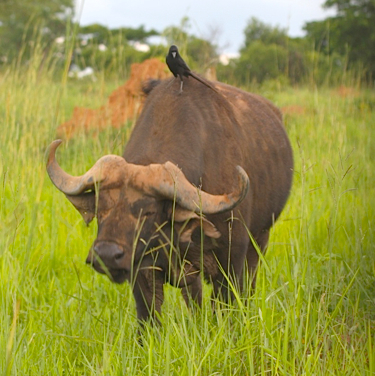
African Buffalo
are considered one of Africa's most dangerous large
mammals; the Piapiac on its back doesn't seem very
concerned though. (Photo by guide Phil Gregory)
BOEHM'S BUSH SQUIRREL (Paraxerus boehmi)
BANDED MONGOOSE
(Mungos mungo)
DWARF MONGOOSE
(Helogale parvula)
LEOPARD (Panthera pardus)
LION (Panthera leo)
AFRICAN ELEPHANT
(Loxodonta africana)
BURCHELL'S ZEBRA
(Equus burchelli)
WARTHOG (Phacochoerus aethiopicus)
HIPPOPOTAMUS
(Hippopotamus amphibius)
ROTHSCHILD'S
GIRAFFE (Giraffa rothschildi)
SITATUNGA (Tragelaphus spekei)
BUSHBUCK (Tragelaphus scriptus)
AFRICAN BUFFALO
(Syncerus caffer)
BLACK-FRONTED
DUIKER (Cephalophus
nigrifrons)
YELLOW-BACKED
DUIKER (Cephalophus
sylvicultor)
BUSH (GRAY) DUIKER
(Sylvicapra grimmia)
DEFASSA WATERBUCK
(Kobus defassa)
KOB (Kobus kob)
TOPI (Damaliscus lunatus)
HARTEBEEST
(KONGONI) (Alcelaphus
buselaphus)
ORIBI (Ourebia ourebi)
IMPALA (Aepyceros malampus)
Herps
Great Nile Crodiles (Crocodylus niloticus) at Murchison and
the Kazinga Channel.
Agama lizards with blue heads at Masindi
Agamas with orange heads at Murchison
Nile Monitors on 4 days, starting at Entebbe Botanic Gardens
A tortoise sp. seen by Jill as we neared Masindi.
A lovely leaf-green Chameleon was seen near Masindi.
Butterflies
This is always a good tour for them and this year was no
exception, we must have seen well over 40 species including
Mackinnon's Swallowtail, Mocker Swallowtail, Emperor
Swallowtail, Green-spotted Swallowtail, Green Broad-banded
Swallowtail, Green Narrow-banded Swallowtail, Berberia sp,
Eucedra sp. Acraea sp, Acraea penelope, African Map,
Blue-spotted Pansy, Brown Pansy, Middle Blue, Isis Blue, Blue
Mother-of-Pearl, Forest Mother-of-Pearl, African Beak in good
numbers at various sites, African Leopard Fritillary, Blue
Diadem and Sailer sp.
I have included many subspecific names of birds in the
triplist as interest in this field is growing exponentially.
Note that in some cases they can't be pinned down to which
taxon, so those birds are left as binominals only, as of
course are the monotypic species. Data are derived from the
Bird Atlas of Uganda, and the IOC Checklist as these are the
most accurate and up to date resources. Ref.
worldbirdnames.org for a free Excel download of the World Bird
Species, available with or without subspecies and updated
every 3 months or so, fun to look over and easy to amend for
your own purposes, i just found my own Uganda list is getting
very close to 700 at 692 species.
Trip highlights were obviously the Gorilla trek and the
fantastic Shoebill, but others were the Chimps at Budongo, the
Elephants swimming at the Kazinga Channel, the Mubwindi Swamp
walk which is just gorgeous, the amazing Leopard sighting, and
amongst the other birds Lesser Jacana, the Giant Eagle Owl sat
right by the track late pm, Black-bellied Seedcracker by its
nest, the very co-operative male White-spotted Flufftail,
Papyrus Gonolek and Doherty's Bush-shrike and of course the
African Grey Parrots. Phil would add Willard's Sooty Boubou
for its sheer novelty and obscurity, the way we got it without
any calls was very lucky, and that Shining-blue Kingfisher in
such good light was tremendous.
Totals for the tour: 512 bird taxa and 39 mammal taxa








